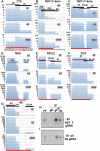Native mitochondrial RNA-binding complexes in kinetoplastid RNA editing differ in guide RNA composition
- PMID: 24865612
- PMCID: PMC4114691
- DOI: 10.1261/rna.044495.114
Native mitochondrial RNA-binding complexes in kinetoplastid RNA editing differ in guide RNA composition
Abstract
Mitochondrial mRNAs in kinetoplastids require extensive U-insertion/deletion editing that progresses 3'-to-5' in small blocks, each directed by a guide RNA (gRNA), and exhibits substrate and developmental stage-specificity by unsolved mechanisms. Here, we address compositionally related factors, collectively known as the mitochondrial RNA-binding complex 1 (MRB1) or gRNA-binding complex (GRBC), that contain gRNA, have a dynamic protein composition, and transiently associate with several mitochondrial factors including RNA editing core complexes (RECC) and ribosomes. MRB1 controls editing by still unknown mechanisms. We performed the first next-generation sequencing study of native subcomplexes of MRB1, immunoselected via either RNA helicase 2 (REH2), that binds RNA and associates with unwinding activity, or MRB3010, that affects an early editing step. The particles contain either REH2 or MRB3010 but share the core GAP1 and other proteins detected by RNA photo-crosslinking. Analyses of the first editing blocks indicate an enrichment of several initiating gRNAs in the MRB3010-purified complex. Our data also indicate fast evolution of mRNA 3' ends and strain-specific alternative 3' editing within 3' UTR or C-terminal protein-coding sequence that could impact mitochondrial physiology. Moreover, we found robust specific copurification of edited and pre-edited mRNAs, suggesting that these particles may bind both mRNA and gRNA editing substrates. We propose that multiple subcomplexes of MRB1 with different RNA/protein composition serve as a scaffold for specific assembly of editing substrates and RECC, thereby forming the editing holoenzyme. The MRB3010-subcomplex may promote early editing through its preferential recruitment of initiating gRNAs.
Keywords: RNA editing; Trypanosoma brucei; deep RNA sequencing; guide RNA; mitochondrial RNA-binding complex MRB1.
© 2014 Madina et al.; Published by Cold Spring Harbor Laboratory Press for the RNA Society.
Figures





Similar articles
-
Native Variants of the MRB1 Complex Exhibit Specialized Functions in Kinetoplastid RNA Editing.PLoS One. 2015 Apr 30;10(4):e0123441. doi: 10.1371/journal.pone.0123441. eCollection 2015. PLoS One. 2015. PMID: 25928631 Free PMC article.
-
REH2C Helicase and GRBC Subcomplexes May Base Pair through mRNA and Small Guide RNA in Kinetoplastid Editosomes.J Biol Chem. 2016 Mar 11;291(11):5753-5764. doi: 10.1074/jbc.M115.708164. Epub 2016 Jan 14. J Biol Chem. 2016. PMID: 26769962 Free PMC article.
-
Dual core processing: MRB1 is an emerging kinetoplast RNA editing complex.Trends Parasitol. 2013 Feb;29(2):91-9. doi: 10.1016/j.pt.2012.11.005. Epub 2013 Jan 8. Trends Parasitol. 2013. PMID: 23305619 Free PMC article. Review.
-
MRB3010 is a core component of the MRB1 complex that facilitates an early step of the kinetoplastid RNA editing process.RNA. 2011 May;17(5):865-77. doi: 10.1261/rna.2446311. Epub 2011 Mar 30. RNA. 2011. PMID: 21451155 Free PMC article.
-
Mitochondrial RNA editing in trypanosomes: small RNAs in control.Biochimie. 2014 May;100:125-31. doi: 10.1016/j.biochi.2014.01.003. Epub 2014 Jan 17. Biochimie. 2014. PMID: 24440637 Free PMC article. Review.
Cited by
-
Structural basis for guide RNA selection by the RESC1-RESC2 complex.Nucleic Acids Res. 2023 May 22;51(9):4602-4612. doi: 10.1093/nar/gkad217. Nucleic Acids Res. 2023. PMID: 36999600 Free PMC article.
-
Trypanosome RNAEditing Substrate Binding Complex integrity and function depends on the upstream action of RESC10.Nucleic Acids Res. 2021 Apr 6;49(6):3557-3572. doi: 10.1093/nar/gkab129. Nucleic Acids Res. 2021. PMID: 33677542 Free PMC article.
-
U-Insertion/Deletion mRNA-Editing Holoenzyme: Definition in Sight.Trends Parasitol. 2016 Feb;32(2):144-156. doi: 10.1016/j.pt.2015.10.004. Epub 2015 Nov 10. Trends Parasitol. 2016. PMID: 26572691 Free PMC article. Review.
-
High-throughput sequencing of partially edited trypanosome mRNAs reveals barriers to editing progression and evidence for alternative editing.RNA. 2016 May;22(5):677-95. doi: 10.1261/rna.055160.115. Epub 2016 Feb 23. RNA. 2016. PMID: 26908922 Free PMC article.
-
Native Variants of the MRB1 Complex Exhibit Specialized Functions in Kinetoplastid RNA Editing.PLoS One. 2015 Apr 30;10(4):e0123441. doi: 10.1371/journal.pone.0123441. eCollection 2015. PLoS One. 2015. PMID: 25928631 Free PMC article.
References
Publication types
MeSH terms
Substances
Associated data
Grants and funding
LinkOut - more resources
Full Text Sources
Other Literature Sources
